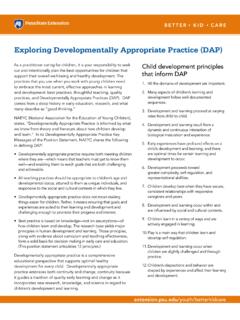Transcription of What is Incidental Teaching? - Knapp Center
1 What is Incidental teaching ? Incidental teaching is a type of teaching used in ABA therapy that follows similar learning principles as Discrete Trial Training, but occurs in a natural environment and the learning opportunity is initiated by the child s interest in an object or activity. Incidental teaching is called so because it takes advantage of naturally occurring incidents to teach important skills. Incidental teaching was initially recognized by Hart and Risley in 1978 and implemented as a method to increase language and improve social responses. It was primarily used among preschool-aged children. However, since its discovery, Incidental teaching has been found applicable to a variety of skills across nearly every age group. What Makes Incidental teaching Effective?
2 Incidental teaching capitalizes on child s highest interest, so child is very motivated. Incidental teaching typically happens in a natural environment. It helps child to generalize skills beyond the ABA therapy work environment and prepares child for when natural environment teaching happens later during program maintenance. It is an evidence-based practice. (See research below) Five Steps Apply these steps when looking for Incidental teaching opportunities and implementing Incidental teaching : 1. Wait for child to initiate teaching by indicating interest. 2. Ask child generic questions such as, What do you need to do? , What do you want/need? 3. Express what you are expecting of child . 4. Prompt as needed. 5. Reward with access and praise.
3 (McGee, Daly, & Jacobs, 1994). Supporting Research for Incidental teaching Betty Hart and Todd R. Risley at the University of Kentucky implemented Incidental teaching strategies to help children with autism learn to use compound sentences. After applying Incidental teaching strategies for learning to use compound sentences while talking to teachers, subjects began using compound sentences directed toward teachers more frequently. When the same strategy was used involving talking to other children, subjects use of compound sentences toward other children doubled. Dennis J. Delprato: Comparisons of Discrete-Trial Normalized Behavioral Language Intervention for Young Children with Autism. Ten controlled studies were reviewed which compared the results of traditional operant behavior procedures (involving highly structured, direct teaching sessions) to normalized language- teaching interventions that had been developed more recently (involving aspects of Incidental teaching such as natural environments and child initiation).
4 This review found that in the eight studies with results involving language criteria, methods similar to Incidental teaching were actually more effective at improving language than more traditional, more structured methods. H. Goldstein-Communication Intervention for Children with Autism. About 60 studies examining multiple interventions for teaching language to children with ASD were reviewed. Interventions reviewed included Incidental teaching and other natural-environment strategies, sign language, DTT, functional communication training, modeling/scripting interactions, and parent training. Incidental teaching and similar natural-environment strategies were found applicable for teaching language and about as affective as DTT. McGee and Daly- Incidental teaching of age-appropriate social phrases to children with autism.
5 This study used Incidental teaching approaches to facilitate the use of socially appropriate speech with peers in three young boys with autism. The Incidental teaching of socially appropriate phrases, such as All right. and You know what? led to immediate use of target phrases in subjects. Later, subjects who had been taught with Incidental teaching strategies showed more use of target phrases while in social play situations. Delprato, (2001). Comparisons of discrete-trial and normalized behavioral intervention for young children with autism. Journal of Autism and Developmental Disorders, 31, 315-325. Goldstein, H. (2002). Communication intervention for children with autism: A review of treatment efficacy. Journal of Autism and Developmental Disorders, 32, 373-396.
6 McGee G. G. Daly T. (2007) Incidental teaching of age-appropriate social phrases to children with autism. Research and Practice for Persons with Severe Disabilities. 32(2), pp. 112-123 Read Abstract (New Window) When and How Can Incidental teaching Be Used To Teach? (Examples) During Mealtime/Snacks While presenting desired food or drink, ask child , What do you want? or What is this? If prompt is required tell child desired response: You can say, Cookie. You can say, Juice . Depending on child s level the word can be expanded to a phrase instead: You can say, I want juice. Give desired food or drink after response (prompted or unprompted). [Language skills, Imitation skills] If child is working on use of utensils and usually requires help, use opportunity to encourage independence.
7 Refrain from help initially, encouraging child to attempt on own, and prompt as necessary. [Adaptive and self-help skills, Language skills] Hand child napkin or cloth after eating and ask child to clean up face/hands. Prompt only as necessary. [Adaptive and self-help skills] Encourage language use and choice-making by setting out multiple options of food and drink and saying, Tell me what you want or Pick one. Prompt as necessary by saying You can say, I want this or You can followed by pointing or using PECS or signs. [Language skills] Involve children in cooking and baking. [Adaptive and self-help skills] Ask child to help measure ingredients, place ingredients where they should go, stir mixes, use utensils, place batter on cookie sheet, etc.
8 [Fine and gross motor skills] Practice figuring out times for cooking and baking and setting timers. [Adaptive and self-help skills, Math skills] At School Facilitate interaction with peers during appropriate times. Prompt with suggestions for starting or responding to conversation: You can say, Hi! You can ask, Can I play? Encourage child to expand on conversations. [Play/Social Skills, Language Skills] Encourage sharing with peers and practice turn-taking. [Play/Social Skills] Practice cleaning up after self and putting things away appropriately in cubby, locker, bins, etc. [Adaptive and Self-Help Skills] If child needs help with an assignment, before helping, allow child opportunity to request the help appropriately with words, signs, PECS, or communicative device.
9 Prompt as necessary and help after it has been requested. [Language skills] When child needs help from teacher, prompt appropriate attention-getting strategies. This could mean prompting child to raise hand, telling child You can ask for help , encouraging use of inside voice . Consistently positively reinforce child for waiting his/her turn, sitting nicely, raising hand, appropriately asking for assistance, and other appropriate classroom behaviors to encourage child to continue using these behaviors. During Play Set out a variety of child s favorite toys. See which toy child gravitates toward. Place toy a certain distance away from child under your control. Prompt child to use words, PECS, or signs to request toy by gesturing toward PECS book, showing appropriate sign, or saying, You can say Teddy bear or You can say car.
10 Give child toy and engage after communication is used. [Language skills] Use puzzles, stringing beads, or other start-to-finish tasks during play if child enjoy these. [Visual/Spatial skills] Remove a few puzzle pieces or beads and prompt child to use words, PECS, or signs to request these when they are needed. [Language skills] If child enjoys books, encourage reading with them. Ask while reading, What is this word? or What is this letter? [Language skills, Academic skills] Or ask child to point to certain pictures in book [Fine motor skills] or certain colors or shapes in book [Fine motor skills, Visual/Spatial skills] while reading. While reading, ask social questions about the story: How does this character feel? Is this a big problem or a little problem?






